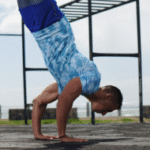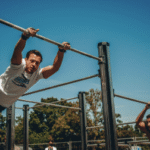Handstand Class: Is it Safe? A Detailed Guide for Beginners
The image of a perfectly balanced handstand is a powerful symbol of strength, control, and grace. For many in Houston’s vibrant fitness community, the desire to learn this impressive skill is strong, but it’s often accompanied by a crucial question: “Is it actually safe to learn?”
The thought of supporting your entire body on your hands can be intimidating, and visions of falling or getting injured are common. The short answer is: yes, a handstand class is overwhelmingly safe, provided it is taught correctly.
A properly structured class in a professional environment is not about throwing you upside down and hoping for the best. It’s a methodical, scientific process designed to build your strength and confidence from the ground up. This guide will detail what makes a handstand class safe, the potential risks, and what you should look for in a quality program.
Understanding the Risks: What Can Go Wrong?
It’s important to first acknowledge the potential risks when learning a handstand, especially without proper guidance. The most common issues are almost always preventable:
Wrist Injury: This is the number one complaint for self-taught handstand enthusiasts. Your wrists are not accustomed to bearing your full body weight. Jumping into it too quickly without proper conditioning can lead to sprains and chronic pain.
Shoulder Strain: Kicking up into a handstand with improper form (like an arched back or unengaged shoulders) puts immense stress on the delicate rotator cuff muscles, which can lead to impingement or strains.
Falling Incorrectly: The fear of falling is real. Without knowing how to safely exit a handstand, a beginner can fall awkwardly, risking injury to their neck, back, or ankles.
The Pillars of Safety: How a Professional Class Mitigates Every Risk
A well-designed handstand class is a controlled environment where every one of the above risks is systematically addressed. Here’s how a qualified coach keeps you safe.
- The Foundation: Conditioning Before Inverting
You won’t be kicking up into a handstand on day one. The majority of a beginner’s class is spent on the ground, building the necessary foundation.
Wrist “Bulletproofing”: Your coach will lead you through a series of specific warm-ups and conditioning drills to strengthen the muscles and tendons in your wrists and forearms. This prepares them to safely handle the load.
Shoulder Stability: You will work on exercises like planks , pike push-ups , and scapular shrugs . These build the crucial shoulder strength and stability needed to hold your body in a straight, safe line.
Core Strength: A handstand is a “plank in the air.” A significant portion of the class will be dedicated to core-compressing exercises like hollow body holds and L-sits to build the rigid trunk necessary for balance.
- The Art of the Safe Exit: Learning to Fall
This is a non-negotiable part of any reputable handstand class and the ultimate confidence builder.
The Cartwheel Bail: Your coach will teach you how to fall by simply turning your body and landing on your feet, like a slow, controlled cartwheel. You will practice this from low-impact positions until it becomes second nature. Knowing you have a safe exit strategy removes the fear of falling and allows you to practice with confidence.
- The Power of Progression: Earning Your Handstand
You will never be asked to perform a skill your body isn’t prepared for. A coach will guide you through a logical, step-by-step progression.
The Wall is Your Best Friend: You will start by using the wall for support. You’ll learn to hold a wall-facing handstand , which is the safest way to get comfortable being upside down and build endurance.
Drills, Not Just Holds: You won’t just stand against the wall. You’ll perform specific drills—like shoulder taps and hip shifts—to learn how to balance and control your weight.
Expert Spotting: When you are ready to start balancing away from the wall, your coach will be there to physically spot you. They know how to support your body, prevent you from falling, and provide the real-time feedback you need to find your balance point.
What to Look for in a Safe Handstand Class in Houston
When choosing a class, look for these signs of a professional, safety-first program:
A Focus on the Warm-Up: The class should begin with at least 10-15 minutes dedicated to wrist and shoulder preparation.
Emphasis on Foundational Strength: A significant portion of the class should be dedicated to conditioning exercises.
Use of Progressions: The coach should be working with students at various levels, offering different progressions for each drill.
Clear Instruction on How to Fall: The coach should actively teach and drill safe exit strategies.
A Supportive, Non-Intimidating Environment: The atmosphere should be encouraging, where “failure” is seen as a normal part of the learning process.
Conclusion:
Is a handstand class safe? When taught by a qualified instructor in a professional setting, it is not only safe but is the safest possible way to learn this challenging and rewarding skill. The structured approach of conditioning the body, teaching safe exit strategies, and using logical progressions removes the risks associated with self-teaching. By investing in a quality class, you are not just learning a cool skill; you are investing in a safe, intelligent, and empowering fitness journey.

Handstand Class: Is it Safe? A Detailed Guide for Beginners
Route
Calisthenics Gym Houston Functional Bodyweight Training
Secondary phone: (346) 483-3195
Email: info@calisthenicsclubhouston.com
URL: https://calisthenicsclubhouston.com/
Monday 6:00 AM - 7:00 PM Tuesday 6:00 AM - 7:00 PM Wednesday 6:00 AM - 7:00 PM Thursday 6:00 AM - 7:00 PM Friday 12:00 PM - 6:30 PM Saturday 9:45 AM - 12:00 PM Sunday 3:00 PM - 5:00 PM





